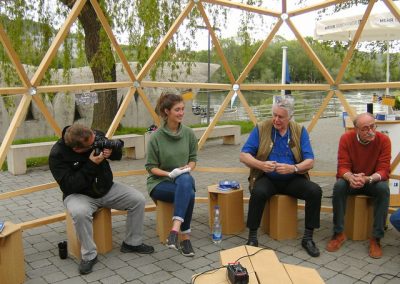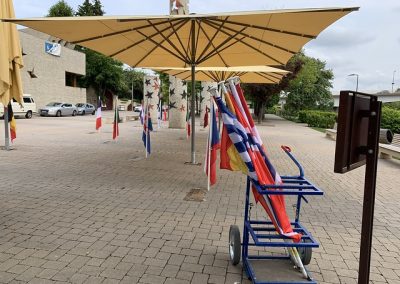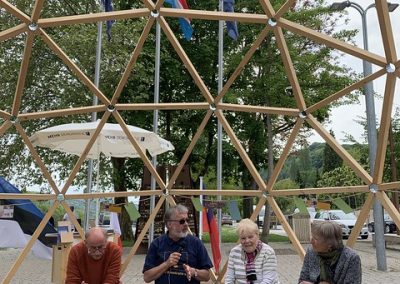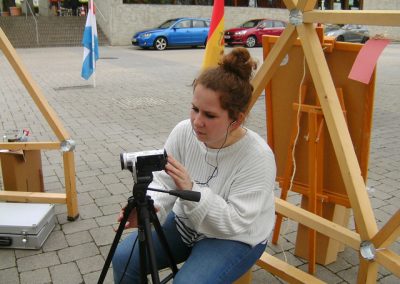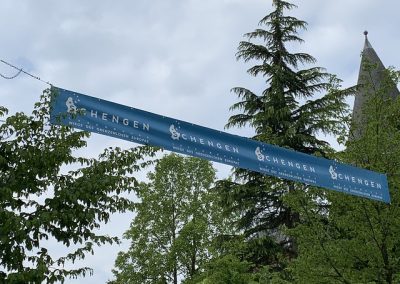Schengen – Borderless Europe
Schengen| With the two stops in Luxembourg, the BeNeLux-Tour of the European Public Sphere was slowly coming to an end. But it was not over yet. Both Schengen and Luxembourg City were vital stops for our Dome Talks and delivered with vibrant discussions. Our intern Helene Paul reports back from the events.
The first stop was Schengen, arguably the most European city of the European Union (EU). There, nested in the border triangle of Luxembourg, France, and Germany, advantages of the European Union can be felt on-site. These positive associations with Europe are a result of the mixture of languages that can be heard all around, the quick and easy border crossing that can almost happen accidentally, the diversity of people, and the historical relevance of the city of Schengen.
Building on these prerequisites, the Dome talks focused on the EU-specific topics of integration and regional organization. But first, the Dome had to be erected. Conveniently, we could make use of the absence of borders and rent an affordable apartment in Germany. That way, we only had to drive 20 minutes and easily made it to Schengen on time, despite it still being an early morning.

The Dome from the bridge taken on German ground
Maybe we’re missing a project (…). Shouldn’t we simply launch new topics, like innovation, everything that’s digital, everything that has to do with research on artificial intelligence? There are so many things we could be doing in Europe, we’re losing our capacities, our skills for exploiting what we have in Europe.
Having arrived, all permits and preparations for building the Dome were in order and we could get right to it. We were lucky to have the support of Alfred Groff of the Initiativ fir Demokratie-Erweiderung and the team of Mehr Demokratie Saarland who volunteered in helping us set up and assembling the Dome, one screw at a time. As most of us were inexperienced builders and Anne, leader of the project and a professional in building it, was hindered by an injury, it took us quite a bit longer than usually. Fortunately, the long building process could not break our spirits and seeing it come together piece by piece further pushed us along.
Finally, the Dome stood proudly amidst the flags of the Member States of the Schengen Agreement, right in front of the European Museum and along the riverside, with the city/region’s slogan in the background: “The cradle of a borderless Europe”. It was quite fitting that our Dome had already crossed a multitude of country borders up until this point and thus stood as another example of what Europe means to us as well as of what we can make of Europe.
The first Dome Talk started right after we finished setting up and focused on EU integration. This round allowed all participants to give a first statement of what the EU meant to them and what they wanted to talk about regarding Europe. With keeping in mind integration, the topic quickly evolved and brought up issues such as the surge of nationalism, how we have (insufficiently) dealt with the migration crisis and how such issues would need to be addressed in the future. The various comments demonstrated that Member States should increase their cooperation in these issues and face the challenge with collective action rather than with isolated measures. At the heart of all arguments was also the necessity of keeping in mind democracy, strengthening democracy through cooperation and always striving for solutions that include citizens and civil society.
Finally, the participants also voiced that citizens therein also play a part. Taking action on their part is regarded as imperative in the question of how to solve current political problems, essentially voicing their concerns so politicians feel the pressure to act.

Luxembourgish, Germans, French, Brits, all under the roof of the Europe Dome
Video of the Dome Talks in Luxembourg
A highlight of the first talk was also the participation of a British couple, giving us insights into their personal experience and opinions on Brexit, further highlighting positive aspects of integration by telling us about their regular European holidays, always without borders.
After a lunch break and a necessary cup of coffee, we then continued with our second Dome Talk. The topic for this talk was EU regions. During this session, we welcomed a French couple who made some interesting comments on how the EU could be felt or was perceived where they came from. A recurring theme was then that people often do not really get in touch with the EU or the idea of Europe where they live and only perceive the negative sides of EU regulations. Education and the way in which Europe and the EU is being taught in school also came up as a critical point.
In regards to the current youth protests arguments were raised on the willingness of the generation to be political and that we would now need to capitalize on these developments, also make Europe a discussion point and try to engage the youth population not yet informed or willing enough to participate as well as carry the dynamic over to all of society.
Both talks built upon a multitude of opinions and perspectives, especially the personal experiences of the two couples on vacation from Great Britain and France gave great input for the discussion. It is always interesting to see where different people put emphasis, be it culture, education or politics.
Building down the Dome then went faster than putting it up, as it usually does. Collective efforts were again the determining dynamic of making it work. Tackling the challenge together is what makes our project possible, and it is what makes Europe possible.
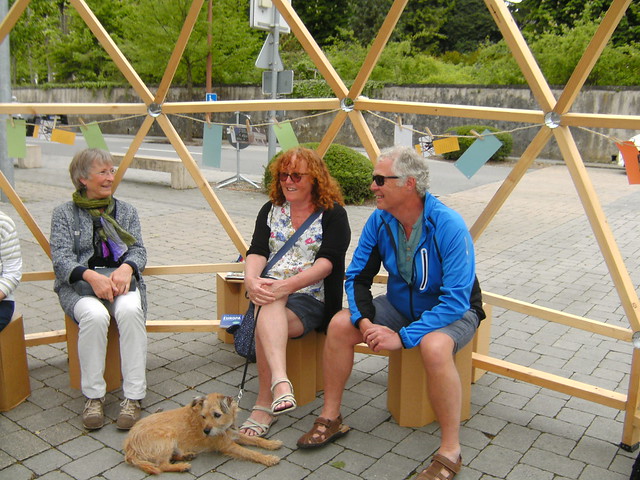
The British couple

 Activities
Activities Future Archive
Future Archive Join us!
Join us! About us
About us

